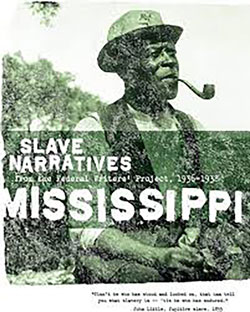A Historical Perspective on American Slavery
 Slavery is one of those subjects of American history that is highly charged emotionally and wrapped in the sensitivities of both historical and modern political agendas. Any discussion of slavery is unfortunately very much bound by the chains of modern political correctness and woke cancel-culture. This severely hinders a historically accurate and realistic perspective on American slavery. Unvarnished and uninhibited truth on this important aspect of American history is sorely needed.
Slavery is one of those subjects of American history that is highly charged emotionally and wrapped in the sensitivities of both historical and modern political agendas. Any discussion of slavery is unfortunately very much bound by the chains of modern political correctness and woke cancel-culture. This severely hinders a historically accurate and realistic perspective on American slavery. Unvarnished and uninhibited truth on this important aspect of American history is sorely needed.
The image of American slavery in the minds of most people today is one of chains, bullwhips, cruelty, and arrogant human abuse. This was often true of the transportation of slaves associated with the slave trade but was largely untrue of the practice of slavery on American shores. The actual practice of slavery in America was in the vast majority of cases considerably more benign than its modern image. There were, of course, many inherent flaws in slavery as a social and economic system that limited social and economic justice and opportunity. Some inexcusable human abuses did occur under American slavery and should not be condoned, but such abuses were far less common than generally assumed. Even Harriet Beecher Stowe’s Uncle Tom’s Cabin, based principally on accounts of runaway slaves, Southern newspaper records of slave masters prosecuted by Southern state governments, and only very limited firsthand familiarity with the South, gives a more balanced picture of slavery than the common modern image.
This article will focus on the treatment of slaves prior to the 13th Amendment to the U.S. Constitution in 1865, but American slavery first needs to be seen in the perspective of world slavery. The universal evidence of history indicates that the institution of slavery in various forms existed from the most ancient times in every recorded civilization. Until the last two centuries it was viewed as an acceptable form of social and economic organization. Slaves were among the earliest commodities traded in the ancient civilizations of the Middle East and Egypt. They were often the spoils of war and raids. Many brides were first taken as slaves. Three quarters of the inhabitants of Athens in its fourth century BC flowering of democracy were slaves.
About 2000 BC, the Hebrew patriarch Abraham held many bondslaves. In most biblical contexts, bondslaves or bonded servants were legally equivalent to slaves as opposed to hired servants. They generally had more security than hired servants, and because they were also generally more trustworthy and dependable, held a higher social status. While the Bible generally implies that freedom is preferable to slavery, it neither endorses nor condemns slavery. Biblical passages such as Leviticus 25 simply regulate slavery, indicating the circumstances in which it is permissible and emphasizing the necessity for fair and humane treatment of slaves.
In their territorial expansion beginning in the third century BC, the Romans began to accumulate millions of slaves. By the second century BC slaves made up 75 percent of the population of Italy. Julius Caesar possessed only modest wealth before he conquered Gaul. He returned with many Gallic slaves and became fabulously rich. Roman slavery was not generally as harsh as depicted in American movies. Roman magistrates were bound by law to consider complaints of slaves against their masters. Killing a slave was considered murder. Roman justice for both slaves and citizens was greatest during the Republic and then declined during the Empire. Yet there remained many opportunities under Roman law for slaves to gain their freedom. During the first century, the time of Christ and the Apostles, slaves declined to less than 40 percent of the Italian population.
The Arabs were also notable slave traders, and slavery increased as the Arab world became largely Muslim. The Koran approves of slavery but limits it to non-Muslims and regulates their treatment. Scandinavian Vikings also engaged in the slave trade, which was a source of both wealth and wives.
The first American slave ship, The Desire, commissioned in 1638, brought back the first cargo of African slaves. The slave trading business soon proved irresistibly profitable. New England slave ships could sail to West Africa and trade less than $100 worth of rum for a slave that could be sold for $650 or more in the Americas. Unlike the way it was depicted in the entertaining but often historically inaccurate novel, Roots, by Alex Haley, it was never necessary to venture into the West African jungles to round up a cargo of slaves. They were simply purchased from West African chieftains, specialists in supplying human cargos for European and New England merchant shipping. The return trip from Africa, known as the “Middle Passage,” usually took from four to nine weeks, depending on the weather. Typically 250 slaves were confined to an under deck area less than 46 inches high and allowing only about eight to nine square feet of floor space per person. For security purposes the males were usually kept chained. Seasickness, dysentery, and contagious diseases combined to kill eight to ten percent of their human merchandise.
Between 1780 and 1799 News York, Pennsylvania, and the New England states initiated gradual emancipation laws but sold their slaves to Southern planters before actual emancipation was required.
SOUTHERN SLAVERY AS IT REALLY WAS
The two richest sources on the actual conditions of slavery in the South prior to its Constitutional end are Robert Fogel and Stanley Engerman’s formidable academic study entitled, Time on the Cross, published in 1974, and the Roosevelt Administration’s publication record of interviews of about 2,300 former slaves conducted from 1936 through 1938. These systematically designed interviews were published by state in a multi-volume series usually called The Slave Narratives. Because these two sources combined give both statistical data and thousands of eyewitness testimonies, they are a historical gold mine. However, because they both present a historical account of Southern slavery generally contradictory to what is now fashionable or even mandatory in most academic, media, and government circles, they are now largely neglected. Although academic freedom in under attack in the U.S. and other Western countries, The Slave Narratives are presently available on the internet. More than a dozen of the state volumes are available in paperback from Amazon.
Despite the South’s largely agricultural economy, only about 26 percent of Southern families actually owned slaves. Many people, including even prominent slave owners, saw slavery as extremely dangerous and inconsistent with their concept of liberty. Among these were Washington, Jefferson, Patrick Henry, Richard Henry Lee, Robert E. Lee, and John Randolph. Probably, a majority of Southerners would gladly have phased out slavery, but no one, North or South, could see how it could be done without causing extreme economic hardship on the South and harming U.S. export trade.
According to Fogel and Engerman, the material conditions of Southern black slaves compared favorably to Northern industrial whites. Their caloric intake, for example, was ten percent greater than free whites. The vitamin content of the slave diet far exceeded that of whites and the recommended daily levels established in 1964. The protein content was 110 percent greater and the iron content 230 percent greater than the minimum daily requirement. According to testimonies in The Slave Narratives, it is very evident that slaves enjoyed abundant, varied, and much appreciated food. The reason the nutrient value of the slave diet exceeded that of whites so much was that the whites ate white potatoes, while the slaves enjoyed the much more nutritious sweet potatoes. Most slave families were also allowed their own small gardens, most frequently planted with sweet potatoes.
While most slaves were field hands or household servants, there were significant numbers in other occupations. Seven percent of slaves, almost all of them males, were essentially part of the plantation management staff. Such positions were foremen (or drivers), overseers, and even general managers. In fact, most field foremen were black slaves. Another twelve percent were skilled craftsmen such as carpenters and blacksmiths. About seven percent were semi-skilled, which included teamsters and many household servants.
Housing standards for Southern slaves in 1860 compared favorably to free whites. There were 5.3 persons per white household and 5.2 persons per slave household. Only rarely was there more than one family per slave cabin. Most slave cabins were about 360 square feet of ground space plus sleeping lofts for children and some porch space. This exceeded the average living space of New York City households in 1892.
Medical care for the average Southern slave was considerably better than for the white Northern factory worker. Most larger plantations maintained a substantial hospital. These were usually visited by the same doctor that treated the plantation owners and white employees. The largest plantations had full-time doctors. The hospitals were usually staffed with one or more full-time slaves acting as nurses and midwives. They were typically elderly slaves who could no longer perform physical labor. Other slave-women specialized in caring for the children on the plantation.
The average slave lifespan was only 36 in 1850, comparable to Northern industrial workers and whites in France, Italy, and the Netherlands, but four years less than the average of all American whites. The maternal death rate of slaves in childbearing was 167 per thousand births. While this is very high by modern standards, it was slightly less for slaves than whites. The infant mortality rate for slaves was 183 per thousand, about three percent higher than white Southerners. The slave suicide rate was only one in ten thousand per year, only one third that of whites.
The standard issue of slave clothing was quite adequate. The clothing was not fashionable, but very sturdy. Slaves were generally issued two pairs of shoes per year, made of high quality leather,
Contrary to popular belief, slave owners generally relied on motivational incentives rather than the whip to increase the work efficiency of slaves. Some typical incentives were cash payments, time off, team bonuses, and the opportunity to make money selling produce from their own gardens and small plots of land. Many plantations worked on a task system. A slave was assigned tasks that could be easily accomplished in a day. They usually finished these tasks ahead of schedule and used the time to rest, visit, or work on their own accounts. Some were allowed to work off the plantation to earn additional money.
Another astonishing statistic derived from Fogel and Engerman’s data is that when the cost of food, housing, clothes, and healthcare, plus various kinds of cash incentive pay are added, the total compensation of the average slave was fifteen percent higher than the pay of comparable free agricultural workers in the South. Fogel and Engerman also estimate that the owner share of slave production after expenses was only about 14 percent. Today almost all workers pay more than 14 percent of their income in various payroll taxes. Slave maintenance costs were from cradle to grave. It took slightly more than 21 years from birth to breakeven. Slave labor could not therefore be said to be irresistibly profitable. Slavery was probably a doomed economic system that could not have lasted another generation. Slavery was not the cause of the War and would have ended without the War, just as it did in all other countries.
Also contrary to popular opinion, the slave family was usually kept together and had strong patriarchal rather than matriarchal features. They had de facto ownership of homes and gardens and were allowed to keep incentive and other entrepreneurial earnings for themselves. The unit of plantation distribution was the family. Marriage ceremonies were often performed, although many were de facto.
One moral defect of the slave system was that slave families could be broken up. On average, only one slave in 22 was sold in a year, but the cumulative effect could be destabilizing. At least a third of these were estate sale disbursements. Most family separations occurred because of westward migration.
Roughly 80 percent of the Slave Narrative interviews indicate former slaves had a favorable opinion of their masters, many of them remarkable in their affection and praise. About 5 percent demonstrate an unfavorable memory, some of them shameful. Perhaps the most remarkable impression given by The Slave Narratives is the prevalence of Christian faith and affectionate bonds between master and slave in the South. Those who have been led to see the relationship of master and slave in the South as one of cruel tyranny by masters and suppressed resentment on the part slaves may be stunned to read so many interviews that demonstrate common respect and affection instead. These positive and affectionate recollections are so numerous that they make a strong and immediate impression. You may read some of these in my book, The Un-Civil War: Shattering the Historical Myths, 2011.
Those who are ignorantly or willfully misrepresenting and exaggerating the conditions of Southern slavery are not having a healing impact on American society. Truth is the only real source of healing. Finding the truth, especially in our generation, requires diligent study, educated discernment, and intellectual fortitude. To heal our nation of racial strife and distrust and many other dysfunctional attitudes and errors will take truth, a forgiving spirit, and moral courage.









 Mike Scruggs is the author of two books: The Un-Civil War: Shattering the Historical Myths; and Lessons from the Vietnam War: Truths the Media Never Told You, and over 600 articles on military history, national security, intelligent design, genealogical genetics, immigration, current political affairs, Islam, and the Middle East.
Mike Scruggs is the author of two books: The Un-Civil War: Shattering the Historical Myths; and Lessons from the Vietnam War: Truths the Media Never Told You, and over 600 articles on military history, national security, intelligent design, genealogical genetics, immigration, current political affairs, Islam, and the Middle East. 


